Skimmers are three distinctive species of waterbirds in the genus Rynchops, belonging to the gull and tern family (Laridae). Instantly recognized by their laterally compressed bills with elongated lower mandibles, they feed in a unique way – gliding just above the water’s surface with the lower bill slicing through to snap up fish.
One species, the black skimmer, breeds in North America along Atlantic, Gulf, and Pacific coasts, while the African and Indian skimmers are found on large rivers and lakes of Africa and South Asia. Their striking appearance, unusual feeding style, and dependence on shifting sandbars and beaches make them some of the most remarkable birds of tropical and subtropical waters worldwide.
Black Skimmer
Rynchops niger
- Identification: Medium-sized tern-like bird with black upperparts, white underparts, and a unique long red-and-black bill where the lower mandible extends beyond the upper.
- Where found: Breeds along Atlantic, Gulf, and Pacific coasts of the United States into Mexico; also widespread in Central and South America on coasts and large rivers.
- How to spot: Look for flocks flying low over water with the lower bill slicing the surface; also recognized by sharp barking calls.
- Conservation status: Least Concern globally; in North America listed as a species of high concern due to steep declines from habitat loss, human disturbance, and sea-level rise.
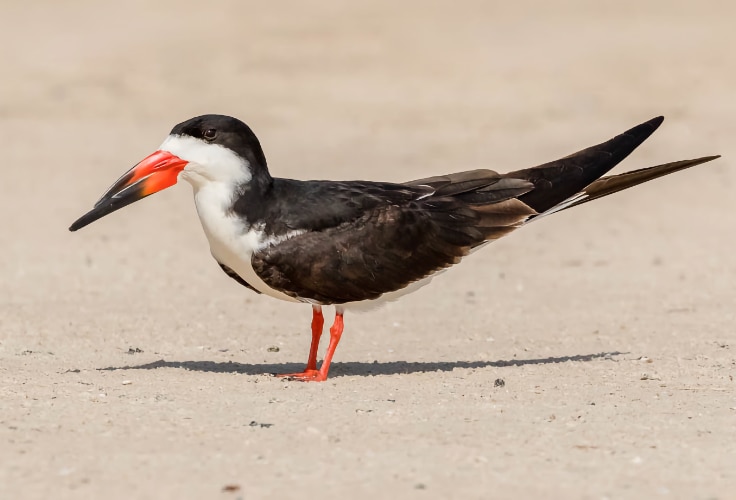
The black skimmer is the only skimmer regularly found in North America and is instantly recognized by its unusual bill. Adults measure 40 to 50 centimeters (15.7 to 19.7 inches) in length, with long narrow wings and bright red-orange legs. The knife-like bill, with its elongated lower mandible, is a striking adaptation for feeding and makes the species unique among birds.
Adults show crisp black upperparts and a contrasting white underside, with a white tail and wing linings. The bill is bright red at the base and black at the tip, and the eye is set in dark plumage, giving the head a masked look. Non-breeding birds develop a white nape collar and browner upperparts. Males are larger than females, but otherwise the sexes look alike. Juveniles are buff-brown and streaked above, pale below, and show a shorter, less pronounced bill at fledging.

In the field, black skimmers are most often detected by behavior. They fly low and straight over estuaries, beaches, and lagoons, gliding with still wings while dipping the lower mandible into the water to seize small fish. At colonies they bark with sharp “yip” calls, often in chorus with neighbors. On the ground they appear squat, sometimes resting with the bill laid on the sand. They forage mainly at dawn, dusk, and night, feeding on killifish, herring, and other small fishes, occasionally adding small crustaceans.
The species breeds colonially on open sandy or shelly substrates along the U.S. Atlantic and Gulf coasts, from Massachusetts to Florida and west to Texas, and on the Pacific coast from southern California into western Mexico. Inland colonies occur locally in Florida and at the Salton Sea in California. Outside North America, skimmers are widespread across Central and South America, breeding on coasts and major rivers such as the Amazon. Nests are shallow scrapes in sand, often in association with terns, and colonies may shift annually depending on disturbance and flooding.
Although secure globally, black skimmers in North America are declining sharply. Surveys show a major population drop since the late 20th century, with the species now on conservation watch lists. The main threats are disturbance and habitat loss on beaches, where human recreation, dogs, and vehicles destroy nests. Rising seas and stronger storms threaten low-lying colonies, while oil spills and pollution affect feeding areas. Management actions such as protecting nesting beaches, restricting vehicle access, and creating dredge-spoil islands have provided some refuge, but long-term persistence will depend on careful habitat protection.
African Skimmer
Rynchops flavirostris
- Identification: Slender black-and-white waterbird with long narrow wings, white underparts, black upperparts, and a striking orange bill where the lower mandible extends beyond the upper.
- Where found: Large rivers and lakes across sub-Saharan Africa from Senegal and Sudan south to Botswana, Namibia, and Mozambique.
- How to spot: Look for groups resting on exposed sandbars and feeding in slow flight with the lower mandible slicing the water; listen for sharp “kip-kip-kip” calls.
- Conservation status: Least Concern globally, though populations are declining due to damming, siltation, disturbance, and egg-collecting in some regions.
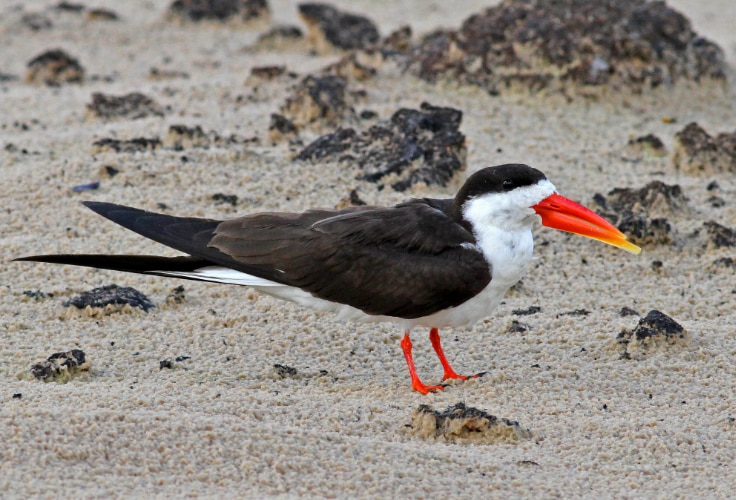
The African skimmer is the only member of its group confined to the continent, and it is unmistakable with its brilliant bill and elegant flight. Adults measure 36 to 42 centimeters (14.2 to 16.5 inches) in length, making it the smallest of the three skimmer species. Long pointed wings and a streamlined body emphasize its tern-like shape, while the unique bill gives it a highly specialized feeding style.
Adults are glossy black above and pure white below, with a white face and forehead offset by a black crown and nape. The bill is vivid orange-red at the base, blending to orange-yellow toward the tip, which is usually pale; the lower mandible projecting well beyond the upper. Legs are bright orange-red. Non-breeding birds show a pale collar on the hindneck and browner upperparts. Juveniles are mottled with buff fringing and have a paler, less vividly colored bill. Males and females look alike, though males are slightly larger.
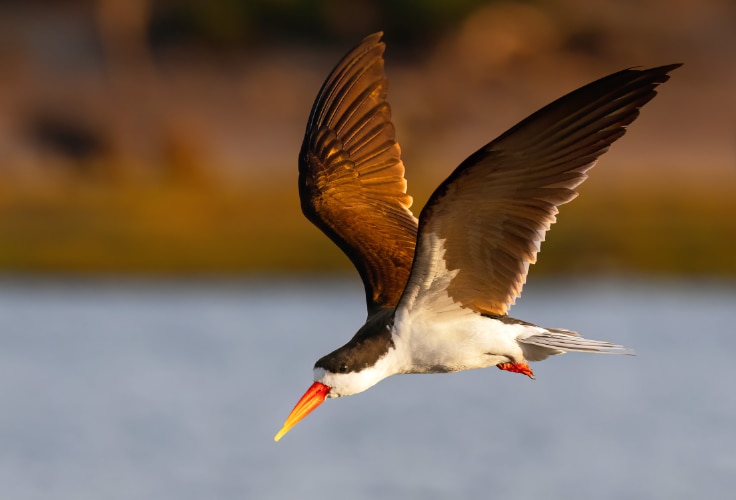
In the field, the African skimmer is most easily identified by its feeding behavior. Birds fly slowly just above the water’s surface, wings stiff and bill open, with the knife-like lower mandible slicing the surface until it touches a fish. Prey are snapped up in mid-flight, sometimes swallowed on the wing. Feeding occurs by day, at dawn, dusk, and often at night. Resting birds gather in tight groups on sandbanks, where they are conspicuous against the bare substrate. Calls include sharp “kip-kip-kip” notes and a harsher tern-like “kreeep.”
This species is widespread across sub-Saharan Africa, ranging from West Africa through the Nile and East African rivers to southern Africa. It is strongly associated with large rivers, lakes, and lagoons, breeding on exposed sandbars and sandy islands during the dry season when water levels are lowest. Colonies are usually small, often fewer than 50 pairs, though non-breeding flocks may number hundreds or more. South of the equator, breeding peaks from July to November, while in West and East Africa nesting is earlier, from March to June.
Although still broadly distributed, African skimmers face multiple threats. Dams and river regulation flood upstream habitats and reduce sandbar availability downstream. Farming and siltation can swamp breeding sites, while egg-collecting, human disturbance, and increasing boat traffic disrupt colonies. In some areas chicks are even used as bait by fishermen. Pollution, pesticide residues, and introduced fish may further affect food supplies. Local conservation efforts, including monitoring, environmental education, and ecotourism in key areas like the Okavango Delta, have been suggested to safeguard this unique riverine bird.
Indian Skimmer
Rynchops albicollis
- Identification: Black above and white below with a broad white forehead, white trailing wing edge, and a vivid orange-yellow bill with the lower mandible much longer than the upper.
- Where found: Rivers of northern and eastern India, Bangladesh, and western Myanmar; winters on coastal estuaries and beaches, especially around the Bay of Bengal.
- How to spot: Look for birds feeding in groups along calm stretches of wide rivers, flying low with long wings while the lower bill slices the surface; listen for sharp barking “kyap” calls.
- Conservation status: Endangered globally; steep population declines from damming, sand mining, altered river flows, disturbance, and predation at colonies.
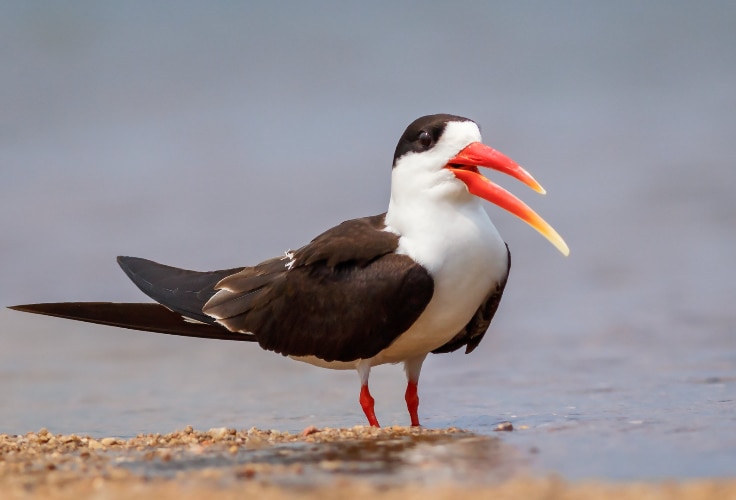
The Indian skimmer is the rarest and most threatened member of its group, once widespread across South and Southeast Asia but now largely restricted to rivers of the Indian subcontinent. Adults measure 38 to 43 centimeters (15.0 to 16.9 inches) in length, with long angular wings, short red legs, and a strikingly patterned head. It is instantly recognizable by its distinctive bill, adapted for feeding by skimming.
Adults are sharply marked black above and white below, with a broad white forehead and collar, and a clean white trailing edge to the wings visible in flight. The long bill is orange-red at the base, shading to yellow toward the tip, with the lower mandible much longer than the upper. The tail is mostly white with a faint dark center line. Males and females look alike, though males are slightly larger. Non-breeding adults are browner above, with mottled hindneck and rump, while juveniles are duller still, mottled and scaled with buff fringing, and have a shorter, paler bill.
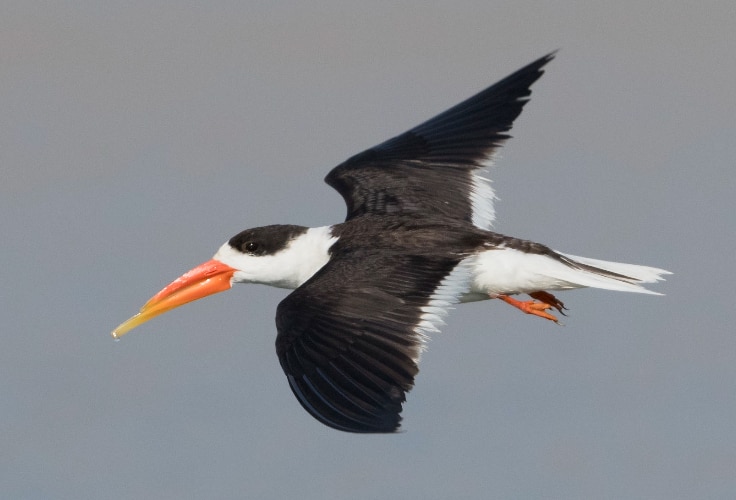
In the field, Indian skimmers are often encountered in colonies or feeding flocks on wide sandy rivers. They fly steadily just above the surface, bills open, the lower mandible cutting the water until it contacts a fish, which is then snapped up. They feed by day, twilight, and even moonlit nights, taking small fish, shrimp, and aquatic insect larvae from shallow water. Their calls are nasal, dog-like barks, “kyap kyap,” often given in alarm or during social interactions. On sandbanks they rest in tight groups, frequently alongside terns.
The species breeds on exposed sandbars and sandy islands of large lowland rivers such as the Chambal, Ganges, and Brahmaputra in India, and the Padma and Meghna in Bangladesh. Colonies are usually formed during the dry season, when water levels are lowest and sandbanks most exposed, with nesting from February through June depending on river conditions. After breeding, many birds move to coastal areas, where they gather on estuaries, saltpans, and offshore sandbars through the winter.
Once common from Pakistan to Southeast Asia, the Indian skimmer has vanished from much of its former range, including Laos, Vietnam, and probably Myanmar. Declines are driven by human alteration of rivers: dams and irrigation projects that flood colonies or expose them to predators, sand mining that destroys nesting islands, and disturbance by fishing, livestock, and people. Eggs and chicks are often lost to trampling, predation by dogs and crows, or flooding from erratic water releases. Pollution and overfishing further degrade feeding grounds.
Conservation efforts are underway in India and Bangladesh, including colony monitoring, community protection programs, and recognition of the species as a priority under regional conservation plans. Despite these, breeding success remains low, and long-term survival will depend on protecting river flows and nesting islands while reducing human disturbance.
Skimmers and Their Future
Skimmers stand apart for their extraordinary feeding style and reliance on open sandbars and beaches, habitats that are among the most fragile in the world. The black skimmer remains fairly widespread in the Americas, while the African and Indian skimmers are tied closely to large rivers, where dams, disturbance, and changing water flows pose serious challenges. Protecting colonies from human pressure, securing healthy river systems, and safeguarding coastal habitats will be critical for their survival.



